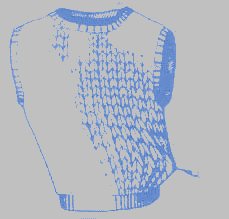I am very interested in the layer of tissue just beneath the skin called the ‘subcutaneous superficial fascia’.
Imagine: a continuous piece of living material just under the skin forming a closed container.
This is your subcutaneous ‘superficial fascia’. It wraps the entire body in a continuous sheath and its thicker in some places (like the upper leg), and thinner in others (as when it passes over the cranium). The thing to remember, though, is it is always continuous.
Bone, tissue, and fascial networks (e.g. subcutaneous, deep, etc.) act in union. Rather than the skeletal system being a ‘static’ framework upon which muscle and tissue are draped, we are a fine balance of tensional nets (e.g. facial layers) and cables (e.g. muscles) stretched across dense struts (i.e. bone).
We might see our bodies as organic ‘tensegrity’ structures: isolated components in compression (e.g. bones) within a net of continuous tension (e.g. specialized tissues).
Which is interesting as an increase of tension or pressure to a tensegrity structure is immediately diffused in distribution through the entire structure.
Or a simpler way of thinking about this is to imagine what occurs when you push your finger into a balloon. The surface tension across the entire balloon changes, not just where you push your finger.
It’s something like this with the subcutaneous superficial fascia. Impact the layer in one place and you affect this layer of fascia across your entire body. And the same applies for the fascial system as a whole.
Take a fall while going down the stairs and twist your ankle, and you can be sure there will be a change to the subcutaneous fascia at the site of impact as well as in the tensional quality of fascia throughout the body.
I believe I witness this frequently when giving Structural Integration (‘Rolfing’) sessions. For example, I’ll be releasing an adhesion at the ribs and the client will be engrossed in a sense of ‘aliveness’ in their leg. Ha!
And the very cool thing is .. release a fascial adhesion anywhere and tension across the whole system decreases :)
Superficial fascia is the lowermost layer of the skin in nearly all of the regions of the body, that blends with the reticular dermis layer. It is present on the face, over the upper portion of the sternocleidomastoid, at the nape of the neck, and overlying the breastbone. It consists mainly of loose areolar, and fatty adipose connective tissue and is the layer that primarily determines the shape of a body. In addition to its subcutaneous presence, superficial fascia surrounds organs and glands, neurovascular bundles, and is found at many other locations where it fills otherwise unoccupied space. It serves as a storage medium of fat and water; as a passageway for lymph, nerve and blood vessels; and as a protective padding to cushion and insulate.
https://en.m.wikipedia.org/wiki/Fascia#Superficial_fascia
Tensegrity, tensional integrity or floating compression is a structural principle based on the use of isolated components in compression inside a net of continuous tension, in such a way that the compressed members (usually bars or struts) do not touch each other and the prestressed tensioned members (usually cables or tendons) delineate the system spatially.
https://en.m.wikipedia.org/wiki/Tensegrity
‘Biotensegrity’, Stephen M. Levin.
http://www.biotensegrity.com
‘The Geometry of Anatomy and the Bones of Tensegrity’, Tom Flemons. http://intensiondesigns.ca/
